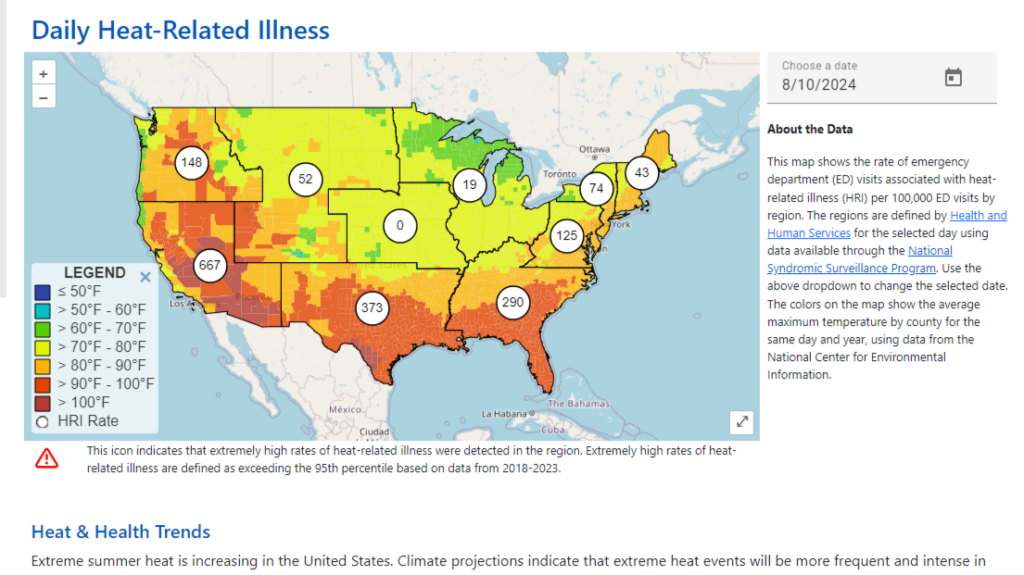NGA, the Centers for Disease Control and Prevention (CDC) and the National Oceanic and Atmospheric Administration (NOAA) recently hosted a briefing on the Heat & Health Dashboard – an interactive tool to help states better understand and mitigate heat risks.

On any given day in summer 2024, tens of millions of Americans are under extreme heat alerts. In addition to more well-known risks, like heat stroke, extreme heat can impact: pregnancy outcomes, heart disease, the safety and efficacy of medications, substance use, bacterial infections and more. By 2050, extreme heat could lead to economic losses of up to $500 million – with agriculture and tourism facing the greatest losses.
Dr. Aaron “Ari” Bernstein, Director of CDC NCEH/ATSDR, and Juli Trtanj, NOAA Climate and Health Program Director, highlighted efforts to better inform and protect Americans from the risks of extreme heat.
A centerpiece of the effort is the first-ever health-based heat forecast, developed by the CDC in conjunction with the National Weather Service. By visiting CDC.gov/heatrisk, Americans from any community nationwide can access a dashboard indicating the local heat risk for their zip code. The dashboard provides a seven-day, color-coded forecast categorizing heat risk from moderate, to major, to extreme – allowing residents to more accurately pinpoint their risk and to plan ahead.
Additional tools connected to the heat risk tool include:
- Heat health tracker: This tool provides information tracking heat risk for zip codes over time and in comparison to other locations – adding context to further assess risk.
- Social vulnerability index (SVI): This composite tool measures a zip code’s risk based on factors like average age, income level and education level.
- Heat and health index: Incorporating the SVI, this tool drills down on heat health risk by considering factors such as the percentage of population with access to health insurance and with limited English-speaking ability.
- Heat action plans: This tool breaks down steps individuals can take (with guidance from their physician) to protect themselves from extreme heat, including: staying cool, staying hydrated, knowing the symptoms, checking air quality, and having a medication plan (including storing medication in a cool place and preparing for power outages that can impact the efficacy of medication). An important element of this tool is helping individuals identify cool places they can go, whether it’s a community cooling center, church, park or neighbor’s home.
- Patient tip sheets and action plans: In addition to the more general heat action plans, CDC also provides guidance customized to specific at-risk populations, including pregnant women, people with heart disease, teens with asthma, caregivers of children with asthma, and more.
Bernstein and Trtanj briefed state government staff on additional resources and initiatives coordinated by their agencies, including the CDC Climate and Health Program’s Climate-Ready States and Cities Initiative; Public Health Infrastructure and Capacity (PHIC) grants; Building Resilience Against Climate Effects (BRACE); and the National Integrated Heat Health Information System (NIHHIS):
Launched in 2015 by NOAA and CDC for a coordinated approach to heat resilience, NIHHIS supports trans-disciplinary work across governmental agencies and non-governmental partners to bridge long-term heat mitigation and short-term planning, in addition to supporting and implementing initiatives developed by the White House Extreme Heat Interagency Working Group. NIHHIS provides updates and resources via a number of channels, including their websiteheat.gov; their Heat Beat Newsletter, and via X/Twitter @HeatGov
NIHHIS helps coordinate local planning in multiple ways, including:
- Urban heat island mapping campaigns: Conducted in over 80 communities, these community-led urban campaigns across the U.S. build upon local partnerships to learn how heat is distributed. Past campaigns have successfully informed city sustainability plans, public health practices, urban forestry plans, and research projects.
- Local Heat Action Planning:
- tabletop exercises: simulate extreme heat events and inform improvements to preparedness, response and long-term resilience
- maturity model for heat governance: allows leaders and decision- makers to evaluate institutional posture and improve heat governance
- Center for Collaborative Heat Monitoring: Supports community science data collection on extreme heat so communities can observe, monitor and evaluate factors influencing heat risk at a local scale
- Center for Heat Resilient Communities: Determines best strategies for mitigating and managing local heat, leveraging federal investments to reduce heat risk, and developing data-driven solutions
As extreme heat and other dangerous weather events increase in frequency and intensity, CDC and NOAA are focused on working with states and local communities to develop and implement improved tools to protect health and enhance community resilience. CDC tools can be found here.












